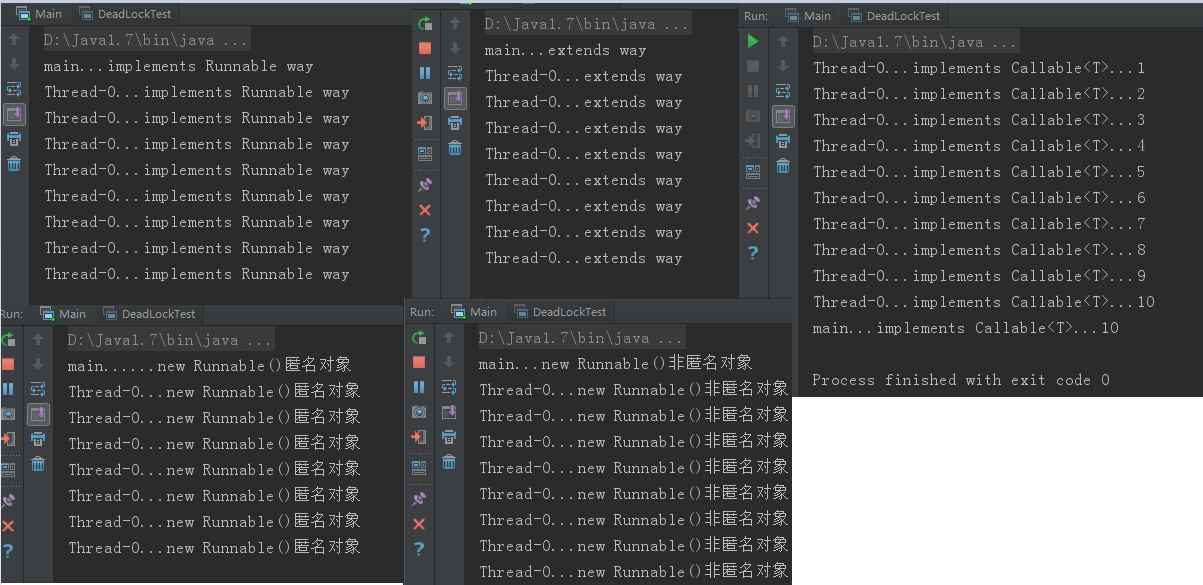实现线程的众所周知的方法具体有2种,但是还有一种,估计不是人人都知道的,没搞过多线程编程的,估计就不知道啦:
(1)继承Thread类,重写run方法
(2)实现Runnable接口,重写run方法
(3)实现Callable接口,重写call方法
(4)线程池的使用
一直天真的以为只有两种方式来实现多线程,直到我真的来仔细琢磨学习了一下这个问题,才知道,Java后来优化了问题。新增了个高级方式。
然后我做如下具体实例来测试。
第一种实现方式:实现Runnable接口,重写run方法
package com.lxk.threadTest.wayToThread;
/**
* Created by lxk on 2017/6/25
* 创建线程方式1实现
* 实现Runnable接口,重写run方法
*/
public class ThreadWay1 implements Runnable {
@Override
public void run() {
for (; ; ) {
try {
Thread.sleep(1000);//毫秒
System.out.println(Thread.currentThread().getName() + "...implements Runnable way");
} catch (InterruptedException e) {
e.printStackTrace();
}
}
}
}第二种实现方式:继承Thread类,重写run方法
package com.lxk.threadTest.wayToThread;
/**
* Created by lxk on 2017/6/25
* 创建线程方式2实现
* 继承Thread类,重写run函数
*/
public class ThreadWay2 extends Thread {
@Override
public void run() {
for (; ; ) {
try {
Thread.sleep(1000);//毫秒
System.out.println(Thread.currentThread().getName() + "...extends way");
} catch (InterruptedException e) {
e.printStackTrace();
}
}
}
}第三种实现方式:实现Callable接口,重写call方法
package com.lxk.threadTest.wayToThread;
import java.util.concurrent.Callable;
/**
* Callable和Runnable有几点不同:
* (1)Callable规定的方法是call(),而Runnable规定的方法是run().
* (2)Callable的任务执行后可返回值,而Runnable的任务是不能返回值的。
* (3)call()方法可抛出异常,而run()方法是不能抛出异常的。
* (4)运行Callable任务可拿到一个Future对象,
* <p>
* Created by lxk on 2017/6/27
*/
public class ThreadWay3 implements Callable<Integer> {
@Override
public Integer call() throws Exception {
int sum = 0;
for (int i = 0; i < 10; i++) {
try {
Thread.sleep(1000);//毫秒
sum += 1;
System.out.println(Thread.currentThread().getName() + "...implements Callable<T>..." + sum);
} catch (InterruptedException e) {
e.printStackTrace();
}
}
return sum;
}
}
只是简单的记录下,如何实现,后面有机会再总结一下这个,我真不常见的这个实现方式。
然后就是在main方法里面调用,运行一下的代码。
package com.lxk.threadTest.wayToThread;
import java.util.concurrent.FutureTask;
/**
* 线程测试(实现多线程的几种方式)
* <p>
* Created by lxk on 2016/11/12
*/
public class Main {
public static void main(String[] args) {
newThreadWay1();//实现Runnable接口
//newThreadWay2();//继承Thread类
//newThreadWay3();//实现Callable接口
//newThreadWay1_();//也就是个简单的匿名对象,直接实现Runnable接口,省去了新建个类的步骤
//newThreadWay1__();//一样也是实现Runnable接口,省去了新建个类的步骤,不过不是匿名对象而已
}
/**
* 创建线程方式1实现
* 实现Runnable接口,重写run方法
* 实现接口的优点:可以方便扩展
*/
private static void newThreadWay1() {
ThreadWay1 threadWay1 = new ThreadWay1();
new Thread(threadWay1).start();
//new Thread(new ThreadWay1()).start();//等于上面的2行代码
System.out.println(Thread.currentThread().getName() + "...implements Runnable way");
}
/**
* 创建线程方式2实现
* 继承Thread类,重写run函数
*/
private static void newThreadWay2() {
ThreadWay2 threadWay2 = new ThreadWay2();
threadWay2.start();
//new ThreadWay2().start();//等于上面的2行代码
System.out.println(Thread.currentThread().getName() + "...extends way");
}
/**
* 创建线程方式3实现
* 实现Callable接口,重写call方法
*/
private static void newThreadWay3() {
int resultFromThread;
try {
ThreadWay3 threadWay3 = new ThreadWay3();
FutureTask<Integer> future = new FutureTask<>(threadWay3);
new Thread(future).start();
Thread.sleep(5000);// 可能做一些事情
//注意:
// 这个有个问题:主线程必须等子线程执行完,才可以继续执行,变成了同步啦,这就不太好啦。失去了多线程的意义啦。
resultFromThread = future.get();
System.out.println(Thread.currentThread().getName() + "...implements Callable<T>..." + resultFromThread);
} catch (Exception e) {
e.printStackTrace();
}
}
/**
* 创建线程方式1实现
* 实现Runnable接口,重写run方法
* (匿名对象:new个线程对象直接开启)
*/
private static void newThreadWay1_() {
new Thread(new Runnable() {
@Override
public void run() {
for (; ; ) {//死循环
try {
Thread.sleep(1000);//毫秒
System.out.println(Thread.currentThread().getName() + "...new Runnable()匿名对象");
} catch (InterruptedException e) {
e.printStackTrace();
}
}
}
}).start();
System.out.println(Thread.currentThread().getName() + "......new Runnable()匿名对象");
}
/**
* 创建线程方式1实现
* 实现Runnable接口,重写run方法
* (实例化一个线程对象,然后调用start方法开启线程)
*/
private static void newThreadWay1__() {
Thread thread = new Thread(new Runnable() {
@Override
public void run() {
for (; ; ) {
try {
Thread.sleep(1000);//毫秒
System.out.println(Thread.currentThread().getName() + "...new Runnable()非匿名对象");
} catch (InterruptedException e) {
e.printStackTrace();
}
}
}
});
thread.start();
System.out.println(Thread.currentThread().getName() + "...new Runnable()非匿名对象");
}
}然后就是各个实现方式 的代码运行结果图 ,如下:
可以看到,起码是看到2个线程在跑,而且,callable接口的main线程是在后面的,是有点特殊的。
一下摘译Java 1.7 jdk的Thread类里面的一段注释
public class Thread implements Runnable {......}
* There are two ways to create a new thread of execution. One is to
* declare a class to be a subclass of <code>Thread</code>. This
* subclass should override the <code>run</code> method of class
* <code>Thread</code>. An instance of the subclass can then be
* allocated and started.
//。。。。。。省略他自带的例子,就是继承Thread类,重写run();
* The other way to create a thread is to declare a class that
* implements the <code>Runnable</code> interface. That class then
* implements the <code>run</code> method. An instance of the class can
* then be allocated, passed as an argument when creating
* <code>Thread</code>, and started.
//。。。。。。省略他自带的例子,就是实现Runnable接口,还是重写run();
第四种:线程池。
实例代码:
package com.lxk.threadTest.wayToThread;
import java.util.ArrayList;
import java.util.Date;
import java.util.List;
import java.util.concurrent.*;
/**
* 线程池
*
* @author lxk on 2018/8/13
*/
public class ThreadPoolWay {
public static void main(String[] args) throws ExecutionException, InterruptedException {
System.out.println("----程序开始运行----");
Date date1 = new Date();
int taskSize = 5;
// 创建一个线程池
ExecutorService pool = Executors.newFixedThreadPool(taskSize);
// 创建多个有返回值的任务
List<Future> list = new ArrayList<>();
for (int i = 0; i < taskSize; i++) {
Callable<String> c = new MyCallable(i + " ");
// 执行任务并获取Future对象
Future f = pool.submit(c);
// System.out.println(">>>" + f.get().toString());
list.add(f);
}
// 关闭线程池
pool.shutdown();
// 获取所有并发任务的运行结果
for (Future f : list) {
// 从Future对象上获取任务的返回值,并输出到控制台
System.out.println(">>>" + f.get().toString());
}
Date date2 = new Date();
System.out.println("----程序结束运行----,程序运行时间【" + (date2.getTime() - date1.getTime()) + "毫秒】");
}
}
class MyCallable implements Callable<String> {
private String taskNum;
MyCallable(String taskNum) {
this.taskNum = taskNum;
}
@Override
public String call() throws Exception {
System.out.println(">>>" + taskNum + "任务启动");
Date dateTmp1 = new Date();
Thread.sleep(1000);
Date dateTmp2 = new Date();
long time = dateTmp2.getTime() - dateTmp1.getTime();
System.out.println(">>>" + taskNum + "任务终止");
return taskNum + "任务返回运行结果,当前任务时间【" + time + "毫秒】";
}
}
代码是直接可运行的。
总结:
看了这个文章,以后谁要是再问,多线程的实现是几种,
那一定得回答:“四种”,这样才显得,嗯,这小伙子,高级。一般的都回答的是2种,太low啦。
一定得记住。


























 被折叠的 条评论
为什么被折叠?
被折叠的 条评论
为什么被折叠?








